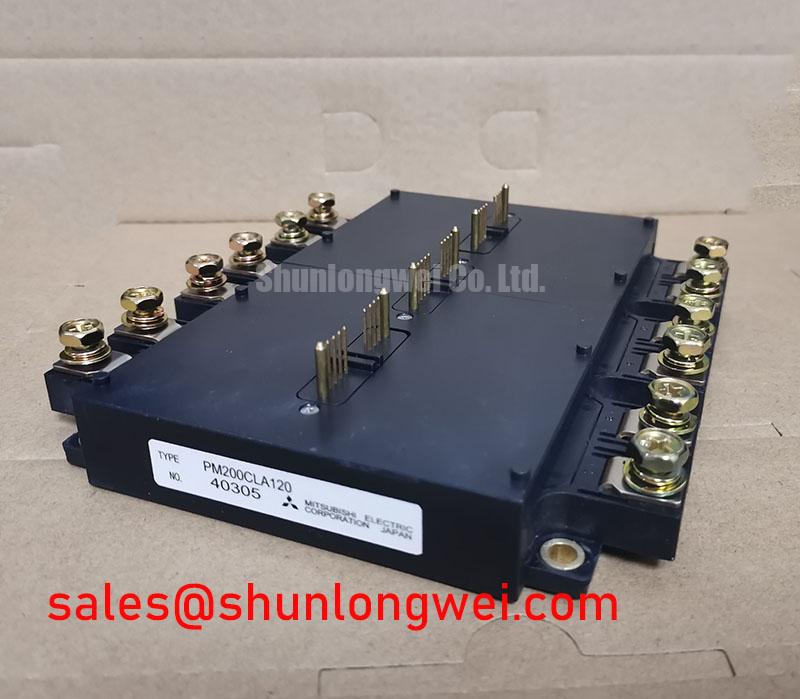Mitsubishi PM200CLA120: Datasheet Insights & Technical Review
A Technical Review of the PM200CLA120 Intelligent Power Module for High-Reliability Motor Drives
This intelligent power module (IPM) delivers superior operational reliability for demanding motor control systems through its integrated, chip-level thermal protection. The Mitsubishi PM200CLA120 offers a robust 1200V | 200A | VCE(sat) 2.3V (Max) rating, engineered for long-term stability. Key benefits include precise, real-time over-temperature detection and reduced system complexity. This design directly addresses the critical engineering challenge of preventing thermal runaway in high-load inverters by embedding temperature sensing directly into the power chip, a significant advantage over solutions relying solely on external thermistors.
System Deployments Demanding Unwavering Thermal Reliability
The PM200CLA120 is specified for applications where operational continuity and long-term durability are primary design considerations. Its architecture is particularly suited for high-power, variable-frequency environments where thermal cycling and peak loads can challenge system integrity.
- General-Purpose and Vector Control Inverters: In applications for 37kW class motors, the module's integrated protection and low-loss CSTBT™ chip technology ensure efficient power conversion and safeguard against common failure modes like short-circuits and overheating.
- Robotic and Servo Drives: Precision motion control systems, such as those found in robotic servo drives, benefit from the IPM's rapid fault detection. This capability ensures the protection of both the drive and the high-value mechanical systems it controls.
- Industrial Automation Machinery: For equipment like CNC machines and automated material handling systems, the module's high reliability translates directly into increased uptime and reduced maintenance overhead, contributing to a lower total cost of ownership.
What is the primary benefit of its integrated protection? It provides a faster, more accurate response to fault conditions than discrete solutions.
Anatomy of Thermal Endurance: A Closer Look at the L-Series Design
The performance of the PM200CLA120 is rooted in Mitsubishi's proprietary technologies and a design philosophy centered on reliability. A key differentiator is the direct integration of protection functions at the silicon level.
The most significant feature is the over-temperature protection mechanism. Unlike conventional designs that rely on an NTC thermistor mounted on the module's baseplate, the PM200CLA120 utilizes the 5th generation CSTBT™ (Carrier Stored Trench-Gate Bipolar Transistor) chips which incorporate temperature sensing functions. This is analogous to having a thermometer embedded directly in an engine's cylinder rather than on the engine block; the measurement is closer to the source of heat, providing a faster and more accurate reading. This allows the IPM to trigger a fault signal before the junction temperature (Tj) reaches a critical failure point, offering a superior level of protection against overload conditions. This proactive thermal management is crucial for preventing the kind of catastrophic failures detailed in IGBT failure analysis.
Data for Design: PM200CLA120 Parameter Cross-Reference
For engineers evaluating power stages, comparing key performance indicators is essential. The following table provides factual data for the PM200CLA120, presented alongside related components to support your design analysis. This is not a recommendation but a provision of data to empower your decision-making. For applications with similar current but different topology needs, the CM200DY-24H provides a dual-IGBT configuration. For systems with lower current requirements, the PM150CSD120 offers a 150A rating within the same voltage class.
| Parameter | Mitsubishi PM200CLA120 | Mitsubishi CM200DY-24H (Reference) | Notes for Evaluation |
|---|---|---|---|
| Configuration | 3-Phase Inverter + Brake | Dual (Half-Bridge) | PM200CLA120 integrates a full 6-pack inverter stage, simplifying 3-phase motor drive designs. |
| Voltage (VCES) | 1200V | 1200V | Both modules are suitable for 400/480V AC line applications with sufficient voltage margin. |
| Current (IC) | 200A | 200A | Matching collector current ratings, but topology dictates final application suitability. |
| VCE(sat) (Typ @ 125°C) | 1.9V | 2.2V | The PM200CLA120's lower saturation voltage indicates lower conduction losses and heat generation. |
| Protection Features | SC, OT, UV (Integrated) | None (External Required) | The IPM nature of the PM200CLA120 reduces external component count and design complexity. |
For systems where component count reduction and built-in protection are prioritized, the integrated nature of the Mitsubishi PM200CLA120 offers a distinct advantage over discrete module solutions.
Meeting Industry 4.0's Uptime Mandates
The push towards smarter, more connected manufacturing (Industry 4.0) places immense pressure on component-level reliability. Unscheduled downtime in an automated production line can lead to significant financial losses. The design philosophy of the PM200CLA120 directly supports this need for enhanced system resilience. By integrating critical protection circuits for short-circuit, under-voltage, and, most importantly, chip-level over-temperature, the module acts as a self-guarding subsystem. The ability to send a fault signal (Fo) from any of the arms provides the system controller with precise diagnostic information, enabling smarter maintenance schedules and faster troubleshooting. This shift from reactive repair to proactive system monitoring is a cornerstone of modern industrial automation.
Specification & Engineering Value Translation
Understanding the datasheet is crucial for effective system design. Below is a breakdown of key parameters for the PM200CLA120, translated into their practical engineering impact. For a deeper guide on interpreting these values, consider reviewing resources on decoding IGBT datasheets.
Download the Datasheet for complete specifications.
| Parameter | Value (from Datasheet) | Engineering Impact |
|---|---|---|
| Collector-Emitter Voltage (VCES) | 1200V | Provides a safe operating margin for industrial applications running on 400V to 480V AC lines, accommodating voltage spikes. |
| Collector Current (IC) | 200A (Tc = 25°C) | Defines the module's capacity to handle the continuous current required for high-power motors, rated for a 37kW class inverter. |
| Collector-Emitter Saturation Voltage (VCE(sat)) | 1.9V (Typ), 2.3V (Max) at Tj=125°C, Ic=200A | A lower VCE(sat) signifies lower power dissipation as heat during conduction. This module's value contributes to higher system efficiency and reduced heatsink requirements. |
| Over Temperature (OT) Protection Trip Level | Tj = 150°C (Typ) | This is the direct chip temperature at which the internal protection circuit triggers, preventing thermal damage far more effectively than an external sensor. |
| Thermal Resistance (Rth(j-c)) | 0.14 °C/W (Per IGBT) | This value represents the efficiency of heat transfer from the semiconductor junction to the case. A lower thermal resistance allows the chip to run cooler, directly enhancing reliability and lifespan. |
Technical Queries on the PM200CLA120
How does the PM200CLA120's over-temperature protection differ from a standard IGBT module with an NTC thermistor?
The PM200CLA120 detects temperature directly on the IGBT chip (Tj), providing an immediate response to thermal stress. A standard module's NTC measures the case or baseplate temperature (Tc), which lags behind the actual chip temperature. This direct sensing method offers a far more effective and faster-acting protection against overload-induced failures.
What is the significance of the "CSTBT" technology mentioned in the datasheet?
CSTBT™ (Carrier Stored Trench-Gate Bipolar Transistor) is a proprietary IGBT technology from Mitsubishi Electric. It is designed to achieve a low collector-emitter saturation voltage (VCE(sat)) even at high temperatures, which reduces conduction losses and improves the module's overall energy efficiency.
Can this IPM be used for applications other than motor control?
Yes, while optimized for general purpose inverters and servo drives, its robust 1200V/200A rating and integrated protections make it a viable candidate for other high-power switching applications, such as industrial power supplies or welding equipment, where reliability is a key requirement.
What gate drive voltage is required for the PM200CLA120?
As an Intelligent Power Module (IPM), the PM200CLA120 includes an integrated gate drive circuit. The logic-level control inputs typically operate at 15V. You do not need to design an external gate driver, which simplifies the system design significantly. Refer to the datasheet for precise input signal specifications.
How does the flat-base package contribute to reliability?
The flat-base design ensures a smooth, uniform contact surface with the heatsink. This minimizes thermal interface resistance, leading to more efficient heat dissipation away from the IGBT chips. Better thermal management keeps the junction temperature lower, which is a primary factor in extending the operational lifetime of a power module.
Field Evidence: Enhancing Drivetrain Uptime
A core challenge in deploying high-power motor drives is managing thermal stress during intermittent overload or in high ambient temperature environments. A system utilizing the Mitsubishi PM200CLA120 Intelligent Power Module leverages its internal Tj detection to proactively flag potential overheating events. Instead of a catastrophic failure, the drive's controller receives a fault signal, allowing it to take corrective action, such as reducing load or activating auxiliary cooling. This transforms a potential system-down event into a manageable condition, directly enhancing equipment availability and aligning with the predictive maintenance goals of modern industrial facilities. How does this benefit the end user? It leads to higher equipment uptime and lower lifetime operational costs.
A Designer's Perspective on Future Optimization
The integration level of the PM200CLA120 offers a solid foundation for reliable power stages. For engineers looking to further enhance system robustness, the focus shifts from the power module itself to the surrounding system. Optimizing the thermal path—through advanced heatsink design and high-conductivity thermal interface materials—will allow the module to operate with an even greater margin below its thermal trip point. Furthermore, leveraging the module's precise fault feedback signals to build sophisticated diagnostic and prognostic routines in the master controller can elevate a system's serviceability, paving the way for truly intelligent and self-aware industrial machinery.















